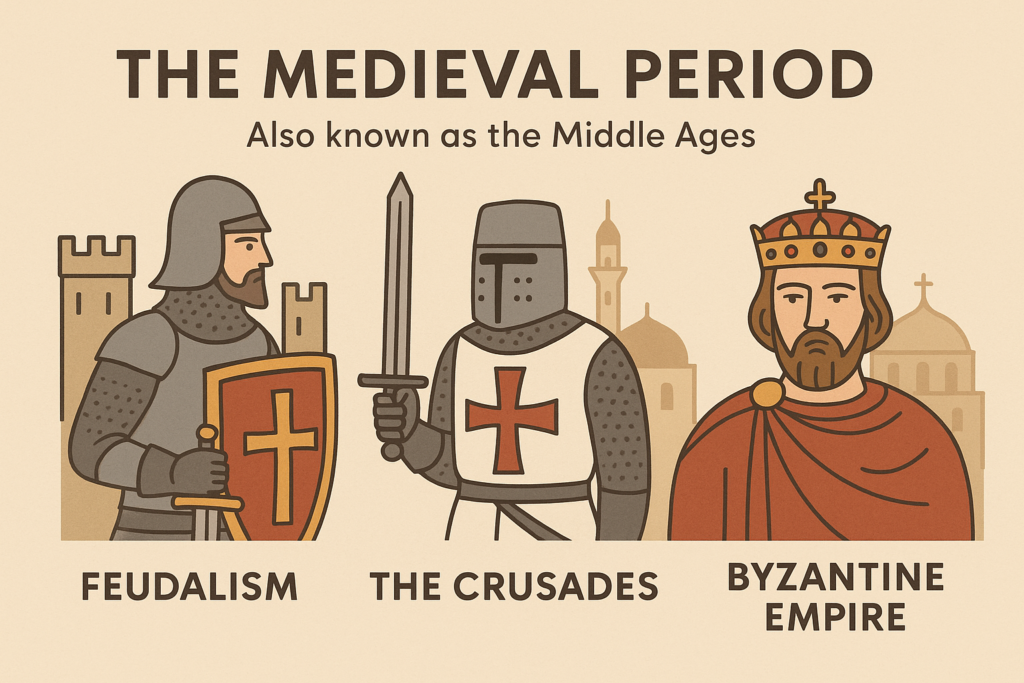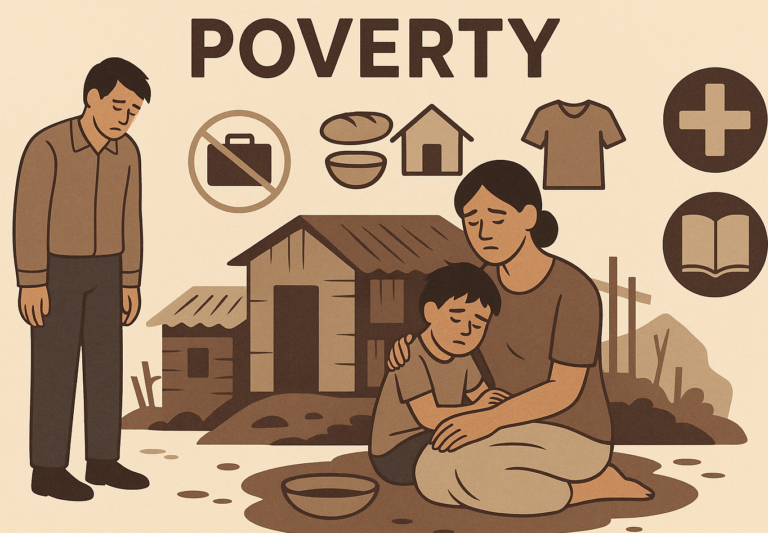The Medieval period, also known as the Middle Ages, spanned roughly from the fall of the Roman Empire in the 5th century to the beginning of the Renaissance in the 15th century. This era was marked by significant changes in society, politics, and culture, and it was shaped by three main elements: feudalism, the Crusades, and the Byzantine Empire. Let’s explore these key aspects of medieval history in an easy and detailed way.

1. Feudalism: The System of Medieval Society
Feudalism was the dominant social, economic, and political system during the medieval period. It was based on land ownership and relationships between different social classes. Here’s how it worked:
Structure of Feudal Society:
- King: At the top of the feudal system was the king. The king owned all the land in the kingdom but granted large portions of it to nobles and lords in exchange for loyalty and military service.
- Nobles and Lords: These were powerful landowners who controlled large estates. They held land from the king and, in turn, granted parts of their land to vassals (knights) in exchange for military service and protection.
- Vassals (Knights): Vassals were lower-ranked lords, often knights, who pledged loyalty to a higher lord in exchange for land and protection. They were trained soldiers who fought for their lords in battles and conflicts.
- Serfs and Peasants: At the bottom of the feudal hierarchy were the serfs and peasants. They worked the land and provided food and resources for the entire feudal system. In return, they received protection from the nobles. While serfs were not slaves, they were tied to the land and could not leave without their lord’s permission.
How Feudalism Worked:
- Land Ownership: Land was the most important asset during the medieval period. The king would give large estates (called fiefs) to the nobles. These nobles would then give parts of their land to vassals (knights) in exchange for military service and protection.
- Loyalty and Service: In return for land, loyalty was exchanged. Vassals promised to support their lords with soldiers in times of war. This created a complex web of relationships based on loyalty, military service, and land control.
- Self-Sufficiency: Most medieval lands were self-sufficient, meaning that everything people needed for survival was produced locally. This often led to villages being isolated, with peasants growing their own food, making their own clothes, and even building their own homes.
Impact of Feudalism:
Feudalism created a system where power was decentralized. The king did not have direct control over all areas of the kingdom; rather, nobles controlled the land, and peasants worked it. This created a society with clear divisions between rich and poor, and where military service and land ownership were the most important aspects of life.
2. The Crusades: Religious Wars with Lasting Impact
The Crusades were a series of religious wars fought between the Christians of Europe and Muslims in the Middle East. The main goal was to capture the Holy Land (Jerusalem) from Muslim rule, but the Crusades had a much broader impact on European society and the world.
Why Did the Crusades Happen?
- Religious Motivation: The Christian church in Europe believed that the Holy Land, especially Jerusalem, was sacred and needed to be reclaimed from Muslim control. Pope Urban II called for the first Crusade in 1095, urging Christians to take up arms and fight for the cause.
- Political and Economic Factors: While religion was a major factor, other motives included the desire for land, wealth, and glory. Nobles saw the Crusades as a way to gain land and resources. Some poor peasants joined in search of adventure or economic opportunity.
- Muslim Expansion: The Muslim forces had expanded into the Middle East, and the Christian rulers of Europe were worried about the threat to Christian holy sites.
Major Crusades:
- First Crusade (1096-1099): The Crusaders successfully captured Jerusalem from Muslim forces. This was considered a major victory for Christians, and many Crusaders established Christian kingdoms in the Holy Land.
- Second Crusade (1147-1149): This Crusade was launched to recapture lands lost to the Muslims. However, it ended in failure for the European forces.
- Third Crusade (1189-1192): Led by famous kings like Richard the Lionheart of England, this Crusade aimed to recapture Jerusalem from the Muslim leader Saladin. While Richard made peace with Saladin, Jerusalem remained under Muslim control.
- Fourth Crusade (1202-1204): Instead of going to the Holy Land, Crusaders ended up attacking Constantinople, the capital of the Byzantine Empire, weakening the empire further.
Impact of the Crusades:
- Cultural Exchange: The Crusades led to increased contact between Europe and the Middle East. This allowed for the exchange of knowledge, ideas, and goods, including scientific advancements, medical knowledge, and luxury items like spices and silks.
- Weakening of Feudalism: Many nobles lost their lands and wealth in the Crusades, which eventually led to a decline in feudal power and the rise of stronger monarchies and centralized governments.
- Religious Tensions: The Crusades deepened religious divisions between Christians and Muslims, and later between Christians and Jews. The idea of religious warfare left a legacy of hatred and mistrust that would affect future relations between these religions.
3. The Byzantine Empire: The Eastern Roman Empire
The Byzantine Empire was the eastern part of the Roman Empire that survived after the fall of Rome in 476 CE. Its capital was Constantinople (modern-day Istanbul), and it lasted for nearly a thousand years, until it fell to the Ottoman Turks in 1453.
The Rise of the Byzantine Empire:
- Splitting of the Roman Empire: After the Roman Empire became too large to govern effectively, it was divided into two parts in 395 CE. The western part of the Roman Empire eventually fell to invading tribes (like the Visigoths and Vandals), but the eastern part, known as the Byzantine Empire, survived for centuries.
- Constantinople: The city of Constantinople was established as the new capital by the Roman Emperor Constantine in 330 CE. The city was strategically located on the shores of the Bosphorus Strait, making it a key center of trade and military power between Europe and Asia.
Key Features of the Byzantine Empire:
- Strong Centralized Government: The Byzantine Empire had a highly centralized government, with the emperor wielding immense power. The emperor was also considered God’s representative on Earth, making the role both political and religious.
- Justinian Code: One of the most important achievements of the Byzantine Empire was the Justinian Code, a collection of laws created by Emperor Justinian I in the 6th century. These laws influenced many modern legal systems.
- Christianity: Christianity was the official religion of the Byzantine Empire. The empire played a major role in preserving and spreading Christian traditions, and it became a center for Christian scholarship and culture. The Eastern Orthodox Church split from the Roman Catholic Church in 1054, creating a major religious division.
Decline and Fall:
- Invasions and Wars: The Byzantine Empire was weakened by constant invasions from various groups, including the Seljuk Turks and the Crusaders. It was also plagued by internal conflicts, corruption, and economic decline.
- The Fall of Constantinople (1453): The empire finally fell when the Ottoman Turks, led by Sultan Mehmed II, captured Constantinople. This marked the end of the Byzantine Empire and the beginning of the Ottoman Empire’s dominance in the region.
Conclusion:
The medieval period was a time of great change, marked by feudalism, the Crusades, and the Byzantine Empire. While feudalism shaped the social and political structure of medieval Europe, the Crusades brought lasting changes in religious and cultural relations. Meanwhile, the Byzantine Empire preserved Roman traditions and Christianity and influenced the development of Eastern Europe. Despite the challenges and conflicts of this era, the Middle Ages laid the foundation for many aspects of modern European culture, law, and governance.











